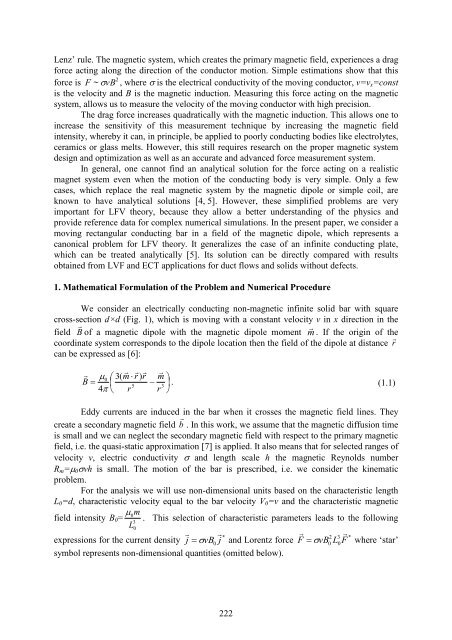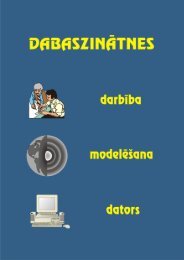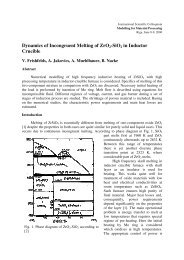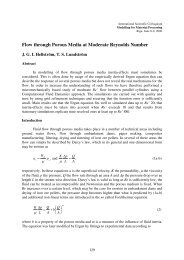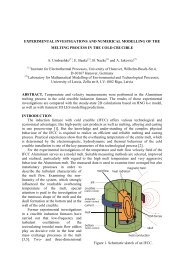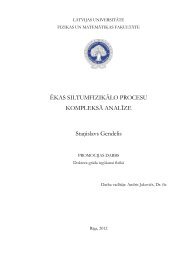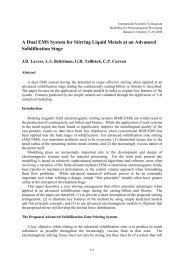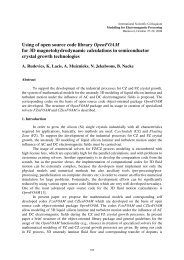Eddy Current Interaction of a Magnetic Dipole with a Translating ...
Eddy Current Interaction of a Magnetic Dipole with a Translating ...
Eddy Current Interaction of a Magnetic Dipole with a Translating ...
You also want an ePaper? Increase the reach of your titles
YUMPU automatically turns print PDFs into web optimized ePapers that Google loves.
Lenz‟ rule. The magnetic system, which creates the primary magnetic field, experiences a dragforce acting along the direction <strong>of</strong> the conductor motion. Simple estimations show that this2force is F ~ vB , where is the electrical conductivity <strong>of</strong> the moving conductor, v=v x =constis the velocity and B is the magnetic induction. Measuring this force acting on the magneticsystem, allows us to measure the velocity <strong>of</strong> the moving conductor <strong>with</strong> high precision.The drag force increases quadratically <strong>with</strong> the magnetic induction. This allows one toincrease the sensitivity <strong>of</strong> this measurement technique by increasing the magnetic fieldintensity, whereby it can, in principle, be applied to poorly conducting bodies like electrolytes,ceramics or glass melts. However, this still requires research on the proper magnetic systemdesign and optimization as well as an accurate and advanced force measurement system.In general, one cannot find an analytical solution for the force acting on a realisticmagnet system even when the motion <strong>of</strong> the conducting body is very simple. Only a fewcases, which replace the real magnetic system by the magnetic dipole or simple coil, areknown to have analytical solutions [4, 5]. However, these simplified problems are veryimportant for LFV theory, because they allow a better understanding <strong>of</strong> the physics andprovide reference data for complex numerical simulations. In the present paper, we consider amoving rectangular conducting bar in a field <strong>of</strong> the magnetic dipole, which represents acanonical problem for LFV theory. It generalizes the case <strong>of</strong> an infinite conducting plate,which can be treated analytically [5]. Its solution can be directly compared <strong>with</strong> resultsobtained from LVF and ECT applications for duct flows and solids <strong>with</strong>out defects.1. Mathematical Formulation <strong>of</strong> the Problem and Numerical ProcedureWe consider an electrically conducting non-magnetic infinite solid bar <strong>with</strong> squarecross-section d×d (Fig. 1), which is moving <strong>with</strong> a constant velocity v in x direction in thefield B <strong>of</strong> a magnetic dipole <strong>with</strong> the magnetic dipole moment m . If the origin <strong>of</strong> thecoordinate system corresponds to the dipole location then the field <strong>of</strong> the dipole at distance r can be expressed as [6]:B 0 3( m r ) r m 5 . (1.1)4 r r 3<strong>Eddy</strong> currents are induced in the bar when it crosses the magnetic field lines. Theycreate a secondary magnetic field b . In this work, we assume that the magnetic diffusion timeis small and we can neglect the secondary magnetic field <strong>with</strong> respect to the primary magneticfield, i.e. the quasi-static approximation [7] is applied. It also means that for selected ranges <strong>of</strong>velocity v, electric conductivity and length scale h the magnetic Reynolds numberR m = 0 vh is small. The motion <strong>of</strong> the bar is prescribed, i.e. we consider the kinematicproblem.For the analysis we will use non-dimensional units based on the characteristic lengthL 0 =d, characteristic velocity equal to the bar velocity V 0 =v and the characteristic magnetic0mfield intensity B 0 =L 3. This selection <strong>of</strong> characteristic parameters leads to the following0 *2 3 *expressions for the current density j vB 0j and Lorentz force F vB0 L0Fwhere „star‟symbol represents non-dimensional quantities (omitted below).222


